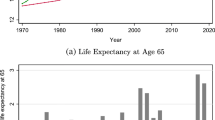Abstract
To what extent can life protection account for observed diversities in age-specific life expectancies across individuals and over time? We provide answers via calibrated simulations of a life-cycle model where life’s end is stochastic, and age-specific mortality hazards are endogenous outcomes of life protection, set jointly with life insurance and annuities. Our model links mortality hazards and values of life saving (VLS) as “dual variables”, and offers new insights about the measurement of VLS. Life protection is estimated to account for non-trivial portions of observed levels and inequalities in life expectancies and empirical estimates of VLS by age and education, and over time.
Similar content being viewed by others
References
AHRQ. (1996). Medical Expenditure Panel Survey [MEPS], the Agency for Healthcare Research and Quality, Rockville, MD.
Aldy, Joseph E. and W. Kip Viscusi. (2004). “Age Variations in Workers’ Value of Statistical Life,” NBER Working Paper #10199.
Bacci, Guido. (1965). Sex Determination. Oxford New York: Pergamon Press.
Barlow, Robin and Bilkis Vissandjee. (1999). “Determinants of National Life Expectancy,” Canadian Journal of Development Studies 20, 9–29.
Davies, James B. (1981). “Uncertain Lifetime, Consumption, and Dissaving in Retirement,” Journal of Political Economy 89, 561–577.
Ehrlich, Isaac. (2000). “Uncertain Lifetime, Life protection, and the Value of Life Saving,” Journal of Health Economics 19(3), 341–367.
Ehrlich, Isaac and Gary S. Becker. (1972). “Market Insurance, Self-Insurance, and Self-Protection,” Journal of Political Economy 80, 623–648.
Ehrlich, Isaac and Hiroyuki Chuma. (1990). “The Demand for Longevity, and the Value of Life Extension,” Journal of Political Economy 98, 761–782.
Frederick, Shane, George Loewenstein, and Ted O’Donoghue. (2002), “Time Discounting and Time Preference: A Critical Review,” Working Paper.
Forster, Martin. (2001). “The Meaning of Death: Some Simulations of a Model of Healthy and Unhealthy Consumption,” Journal Of Health Economics 20, 613–638.
Gerdttham, U.G., M. Johannesson, L. Lunndberg, and D. Isacson. (2000). “The Demand for Health: Results From New Measures of Health Capital,” European Journal of Political Economy 15, 501–521.
Goldman, Dana and Darius Lakdawalla. (2001). “Understanding Health Disparities Across Education Groups,” NBER Working Paper #8328.
Grossman, Michael. (1972). The Demand for Health: A Theoretical and Empirical Investigation. New York: Columbia University Press.
Harvey, James. (1998). “Estimating OSHA Compliance Costs,” Policy Science 31, 321–341.
Johannesson, Magnus, Per-Olov Johansson, and Karl-Gustaf Lofgren. (1997). “On the Value of Changes in Life Expectancy: Blips versus Parametric Changes,” Journal of Risk and Uncertainty 15, 221–239.
Johansson, Per-Olov. (2001). “Is There a Meaningful Definition of the Value of a Statistical Life?” Journal of Health Economics 20, 131–139.
Jones-Lee, Michael W., W.M. Hammerton, and P.R. Philips. (1985). “The Value of Safety: Results of a National Sample Survey,” Economic Journal 95, 49–72.
Judd, Kenneth L. (1998). Numerical Methods in Economics. Cambridge and London: MIT Press.
Kniesner, Thomas J., James P. Ziliak, and W. Kip Viscusi. (2004), “Life-Cycle Consumption and the Age-Adjusted Value of Life,” NBER Working Paper #10266.
Mitchell. Olivia. (2001). “Developments in Decumulation: The Role of Annuity Products in Financing Retirements,” NBER working paper 8567.
Nachtrieb, Lynne. (2003). “Food and Nutrition Information-Fact or Fiction,” Nutrition Times.
Philipson, Tomas and Gary Becker. (1998). “Old-Age Longevity and Mortality-Contingent Claims,” Journal of Political Economy 106, 551–573.
Richards, Hugh and Ronald Barry. (1998). “U.S. Life Tables For 1990 By Sex, Race, and Education,” Journal of Forensic Economics 11, 9–26.
Shepard, Donald S. and Richard J. Zeckhauser. (1984). “Survival versus Consumption,” Management Science 30, pp. 424–439.
Thaler, Richard and Shervin Rosen. (1975). “The Value of Saving a Life: Evidence From The Labor Market.” In N. E. Terleckyj (Ed.), Household Production and Consumption. New York: National Bureau of Economic Research, pp. 265–297.
U.S. Census Bureau, “Historical Income Tables-People, (Table) P-1, Total CPS Population and Per Capita Money Income: 1967 to 1998”, published April, 2000. <http://www.census.gov/hhes/income/histinc/p01.html>>[USCB]
U.S. Census Bureau. (1998). Statistical Abstract of the United States [SAUS].
U.S. Department of Health and Human Services, Vital and Health Statistics, Series 2: Data Evaluation and Methods Research, No. 129, 1999. [VS]
U.S. Department of Health and Human Services, National Vital Statistics Report, Various Volumes.
Viscusi, W. Kip. (1993). “The Value of Risks to Life and Health,” Journal of Economic Literature 31, 1912–1946.
Viscusi, W. Kip and Joseph. E. Aldy. (2003). “The Value of a Statistical Life: A Critical Review of Market Estimates Throughout the World,” Journal of Risk and Uncertainty 27, 5–76.
Author information
Authors and Affiliations
Corresponding author
Additional information
JEL Classification: C6, D8, I1
Rights and permissions
About this article
Cite this article
Ehrlich, I., Yin, Y. Explaining Diversities in Age-Specific Life Expectancies and Values of Life Saving: A Numerical Analysis. J Risk Uncertainty 31, 129–162 (2005). https://doi.org/10.1007/s11166-005-3552-9
Issue Date:
DOI: https://doi.org/10.1007/s11166-005-3552-9




